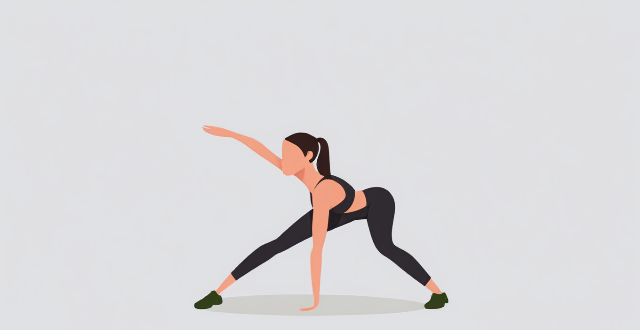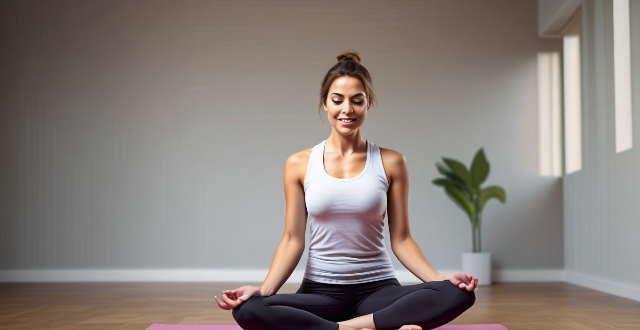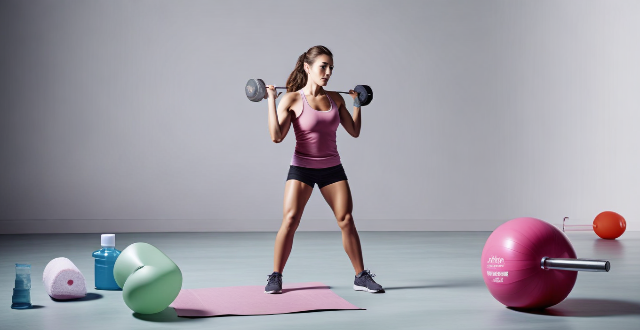Exercise Routine

How can older adults with chronic conditions incorporate exercise into their daily routine ?
Incorporating exercise into the daily routine of older adults with chronic conditions is crucial for maintaining their overall health and well-being. Here are some tips on how they can achieve this: * Start slowly by gradually increasing the duration and intensity of low-impact exercises like walking or swimming. * Choose appropriate exercises that focus on strength training, flexibility, and range of motion to reduce the risk of injury. * Set realistic short-term and long-term goals to build momentum and confidence. * Make exercise a habit by scheduling specific times during the day and creating a routine. * Stay safe and comfortable by wearing appropriate gear, staying hydrated, and seeking professional advice when needed. * Track progress in a journal and celebrate milestones to stay motivated.

Can I drink alcohol after a vigorous exercise routine
Drinking alcohol after a vigorous exercise routine is possible, but it's not recommended due to potential negative effects on hydration, recovery, and nutrition. It's best to prioritize your health by choosing healthy foods and drinks that provide the necessary nutrients for optimal recovery.

Can I continue my regular workout routine during pregnancy ?
During pregnancy, it is important to maintain a healthy lifestyle, including regular exercise. However, consulting with your healthcare provider before continuing any workout routine during pregnancy is crucial. Regular exercise can improve cardiovascular health, reduce the risk of gestational diabetes, and alleviate symptoms of depression and anxiety. It can also help control weight gain during pregnancy and make it easier to lose the baby weight after delivery. Low-impact cardio exercises, strength training, and flexibility exercises are safe options for pregnant women. It is essential to listen to your body, avoid high-risk activities, and stay hydrated and nourished. Seeking professional advice is crucial for first-time pregnancies, multiple gestation pregnancies, and pregnancies with complications. Continuing a regular workout routine during pregnancy can be beneficial for both you and your baby, but making necessary modifications to ensure safety and well-being is essential.

How can I create a sustainable fitness routine for better health ?
Creating a sustainable fitness routine is crucial for maintaining good health and achieving long-term fitness goals. Here are some tips on how to create a sustainable fitness routine: ## 1\. Set Realistic Goals * **Start Small:** Begin with small, achievable goals that you can gradually build upon. This will help you avoid burnout and stay motivated. * **Be Specific:** Clearly define your fitness goals, such as losing weight, gaining muscle, or improving cardiovascular health. ## 2\. Choose an Activity You Enjoy * **Find Your Passion:** Select an exercise that you genuinely enjoy, whether it's running, swimming, cycling, or dancing. This will make it easier to stick to your routine. * **Mix It Up:** Incorporate variety into your workouts by trying different activities or switching up your routine regularly. ## 3\. Make It Part of Your Daily Routine * **Schedule It In:** Treat your workouts as non-negotiable appointments in your calendar. Plan them around your work and personal life commitments. * **Create a Habit:** Aim to exercise at the same time each day to establish a consistent habit. ## 4\. Track Your Progress * **Keep a Journal:** Record your workouts, including the type of exercise, duration, and intensity. This will help you monitor your progress and adjust your routine accordingly. * **Set Milestones:** Celebrate small milestones along the way to stay motivated and focused on your long-term goals. ## 5\. Stay Accountable * **Find a Workout Buddy:** Having a friend or family member to exercise with can provide motivation and accountability. * **Join a Group Class:** Enrolling in group fitness classes can also offer social support and encouragement from others working towards similar goals. ## 6\. Listen to Your Body * **Rest and Recovery:** Allow adequate rest days between workouts to prevent injury and promote recovery. * **Adjust Intensity:** Pay attention to how your body feels during and after exercise. If you're feeling excessively fatigued or experiencing pain, consider reducing the intensity or duration of your workouts. By following these tips, you can create a sustainable fitness routine that supports better health and long-term success. Remember to be patient with yourself and celebrate every step towards achieving your fitness goals!

How often should women exercise to see results ?
Exercising regularly is crucial for women's health, and the recommended frequency varies based on the type of exercise. Cardiovascular exercises are recommended at least 150 minutes per week, while strength training should be done at least twice a week. Flexibility and balance exercises should be included in the routine at least once a week. Various factors such as age, goals, fitness level, lifestyle, and health conditions can impact the effectiveness of the workout routine. It is essential to listen to your body and adjust your exercise routine accordingly to achieve optimal results and maintain a healthy lifestyle.

How much exercise is needed to achieve mental rejuvenation ?
Achieving mental rejuvenation through exercise is a widely discussed topic in recent years, and the benefits of physical activity on mental health are well-documented. However, the question remains: how much exercise is actually needed to achieve these benefits? According to the American Heart Association, adults should aim for at least 150 minutes of moderate-intensity aerobic activity or 75 minutes of vigorous-intensity aerobic activity per week. This can be broken down into 30 minutes of exercise, five days a week. In addition to aerobic activity, it's also recommended that adults engage in muscle-strengthening activities at least two days per week. It's important to listen to your body and adjust your exercise routine accordingly. Practical tips for incorporating exercise into your daily routine include starting small, finding an activity you enjoy, making it a part of your routine, mixing it up, and setting realistic goals. By following these guidelines and tips, you can make exercise a regular part of your life and enjoy the many benefits it brings to both your physical and mental health.

How does exercise affect sleep quality ?
Exercise is crucial for maintaining a healthy lifestyle and has a significant impact on sleep quality. Regular physical activity can improve sleep onset, increase deep sleep, reduce stress and anxiety, regulate body temperature, and promote better breathing during sleep. To incorporate exercise into your daily routine, start slowly, choose enjoyable activities, schedule workouts, mix up your routine, be mindful of timing, listen to your body, stay hydrated, get enough rest, seek support, and track your progress.

Can exercise help manage symptoms of ADHD ?
Exercise can be a powerful tool in managing symptoms of ADHD by improving focus, reducing impulsivity, increasing energy levels, and promoting better sleep. Choosing the right type of exercise, setting realistic goals, and creating a consistent routine are essential for reaping the full benefits of physical activity for ADHD management.

How does exercise help in managing stress ?
Stress is an inevitable part of life, but regular exercise can help manage it effectively. Exercise releases endorphins, reduces muscle tension, improves sleep quality, boosts self-esteem and confidence, provides a sense of accomplishment, and promotes social interaction. To incorporate exercise into your daily routine, start slowly, find an activity you enjoy, make it a part of your routine, mix up your routine, and don't overexert yourself. By doing so, you can reap the numerous benefits of exercise for stress management and overall well-being.

How can older adults stay motivated to exercise regularly ?
Staying motivated to exercise regularly is crucial for older adults to maintain their physical health, mental well-being, and overall quality of life. Here are some strategies that can help them stay on track: 1. Set realistic goals 2. Find an exercise buddy 3. Mix up your routine 4. Track your progress 5. Reward yourself 6. Make it part of your daily routine

How can I incorporate simple yoga moves into my daily routine ?
Incorporating simple yoga moves into your daily routine can improve your health and well-being. Start with basic poses, create a morning or evening routine, take short breaks throughout the day, use yoga as exercise, practice mindfulness and breathing techniques, and join a class or workshop to learn more advanced poses.

How can I incorporate aerobic exercise into my daily routine ?
Incorporating aerobic exercise into your daily routine can improve cardiovascular health, burn calories, and enhance mood and energy levels. Here are ways to seamlessly incorporate aerobic exercise into your day: 1. **Morning Vigor**: Start the day with activities like jogging, cycling, or jump roping. 2. **Lunch Break Activities**: Use your lunch break for stair climbing, walking meetings, or yoga. 3. **Post-Work Energy Booster**: After work, engage in gym sessions, outdoor sports, or dancing. 4. **Evening Wind-Down**: Before bedtime, consider gentle exercises like evening walks, Tai Chi, or swimming. 5. **Weekend Adventures**: On weekends, engage in longer duration exercises like hiking, biking, or water sports. 6. **Lifestyle Integration**: Make aerobic exercise a habit by commuting actively, doing active errands, or using fitness trackers.

What is the daily routine of a celebrity like ?
The text provides an overview of the daily routine of a celebrity, which includes exercise, breakfast, checking social media and emails, work commitments, lunch break, appearances or events, dinner parties, relaxation time, and bedtime routine. Despite their hectic schedules, celebrities prioritize self-care and maintaining a healthy lifestyle.

How long after starting a new exercise routine can improvements in immunity be expected ?
Regular exercise has numerous health benefits, including improved cardiovascular health, weight management, and mental well-being. One of the lesser-known benefits is its positive impact on the immune system. Improvements in immunity can be observed within a few weeks of starting a regular exercise program, depending on individual factors such as current fitness level, intensity and duration of exercise sessions, and overall lifestyle habits. By incorporating regular physical activity into your daily routine, you can enhance your immune function and enjoy the numerous other health benefits associated with exercise.

How long after starting an exercise routine can improvements in cognitive function be expected ?
The text discusses the timeline for improvements in cognitive function after starting an exercise routine. It mentions that immediate benefits such as enhanced mood, improved attention and focus, and increased energy levels can be noticed within 1-3 months. Mid-term benefits like enhanced memory retention, improved executive function, and increased creativity can be observed within 3-6 months. Long-term benefits such as slowed cognitive decline, reduced risk of cognitive disorders, and sustained improvements in overall cognitive performance can be achieved after six months or longer. The text emphasizes the importance of maintaining a consistent exercise regimen over the long term for sustained enhancements in various aspects of cognitive function.

How soon after starting a new exercise routine can one expect to see stress-reducing benefits ?
Starting a new exercise routine can reduce stress, but the time it takes to experience benefits varies. Immediately after starting, there may be a temporary increase in stress levels due to physical exertion and adjustment. Within 1-2 weeks, improvements in mood, sleep quality, and energy levels may be noticed. By 3-4 weeks, more significant stress-reducing benefits such as enhanced cognitive function and reduced stress hormone levels may be experienced. After 5+ weeks of consistent exercise, overall mental health and well-being can improve, resilience to stressors can increase, and the risk of developing anxiety and depressive disorders can decrease.

How long does it take to see improvements in cardiorespiratory fitness from starting an exercise routine ?
When starting an exercise routine to improve cardiorespiratory fitness, noticeable changes can occur within weeks, but significant and lasting improvements typically take several months of consistent training. Factors affecting improvement rates include baseline fitness level, workout frequency and intensity, age, health status, nutrition, recovery, and genetics. To maximize progress, set realistic goals, mix up your routine, monitor your progress, stay consistent, and get adequate rest.

What are the essential steps for a quick makeup routine ?
The essential steps for a quick makeup routine include preparing your skin, priming your face, applying foundation, adding color, defining your eyes, and finishing with lipstick or gloss. This routine can leave you looking polished and put together in no time.

What are some tips for creating a minimalist makeup routine ?
Creating a minimalist makeup routine can save time, money, and space while still looking polished. Focus on skincare first, choose multi-tasking products, stick to neutrals, emphasize one feature at a time, use tools wisely, simplify your routine, practice moderation, and keep it consistent. This approach enhances natural beauty without overwhelming your schedule or vanity.

What are some tips for staying motivated during a gym workout ?
Staying motivated during a gym workout can be challenging, but crucial for maintaining a consistent exercise routine. Tips include setting clear goals, creating an energetic playlist, finding a workout buddy, mixing up your routine, tracking progress, rewarding yourself, visualizing success, embracing challenges, getting adequate rest, and focusing on how exercise makes you feel. By implementing these strategies, you can make the most out of your gym workouts and stay consistent in your fitness journey.

Can regular physical activity prevent depression ?
Regular physical activity can reduce depression risk by releasing endorphins, improving sleep, and boosting self-esteem. Start with 30 minutes daily of activities like walking or swimming, and consider joining a fitness class for motivation. Gradually increase intensity and listen to your body to avoid overexertion.

Is it possible to master a 5-minute makeup routine ?
The text answers the question of whether it is possible to master a 5-minute makeup routine in the affirmative, providing tips on how to achieve a polished look quickly.

Does consistent exercise regulate sleep patterns ?
Consistent exercise has been shown to have a positive impact on sleep patterns, helping regulate the body's internal clock and increase the production of sleep-promoting hormones. Regular physical activity can lead to better sleep quality, reduced stress and anxiety, and improved overall health. To reap these benefits, it's important to incorporate regular exercise into your routine, starting slowly and gradually increasing intensity and duration over time.

Can regular exercise help with insomnia ?
Insomnia, a sleep disorder making it hard to fall or stay asleep, affects many. Regular exercise is emerging as a natural remedy for insomnia. Exercise can positively impact sleep quality and duration by regulating the circadian rhythm and releasing endorphins. It also reduces stress and anxiety, leading causes of insomnia. Regular exercise boosts energy levels and mental health, further promoting better sleep. The recommended amount is 150 minutes of moderate-intensity activity weekly, including muscle-strengthening exercises. Tips for exercising with insomnia include choosing low-impact activities, avoiding high-intensity workouts at night, establishing a routine, being mindful of caffeine intake, and consulting a doctor before starting an exercise program.

Can exercise help with stress management ?
**Topic:** Can Exercise Help with Stress Management? **Summary:** * **Introduction:** The inevitability of stress and its potential impact on health highlight the importance of effective stress management. Exercise is often touted as a beneficial method for reducing stress. * **Relationship Between Exercise and Stress:** * **Physical Effects:** Exercise triggers endorphins, reduces cortisol levels, and improves sleep quality—all of which contribute to stress reduction. * **Mental Effects:** Enhanced cognitive function, increased self-esteem, and mindfulness techniques associated with exercise can aid in stress management. * **Benefits of Exercise for Stress Management:** * **Physical Benefits:** Improved cardiovascular health, weight management, and pain relief can reduce stress caused by related health issues. * **Mental Benefits:** Exercise can alleviate symptoms of anxiety and depression, improve mood, and increase resilience to stress. * **Practical Tips:** * **Setting Goals:** Start small and choose enjoyable activities to make exercise a sustainable habit. * **Consistency:** Scheduling workouts, finding an accountability partner, and tracking progress can help maintain a regular exercise routine. * **Conclusion:** Exercise is a powerful tool for managing stress, offering both physical and mental benefits. Incorporating it into one's lifestyle can significantly enhance overall well-being and resilience to life's challenges.

What are the best workout routines for people with desk jobs ?
Incorporating regular exercise into your routine is essential for counteracting the negative effects of having a desk job, such as back pain, weight gain, and reduced cardiovascular fitness. The best workout routines for people with desk jobs include cardiovascular exercises like walking or jogging, cycling, and swimming; strength training exercises such as bodyweight exercises, resistance bands, and dumbbells or kettlebells; and stretching and mobility exercises like yoga or Pilates, foam rolling, and dynamic stretching. By making exercise a part of your routine, you'll not only counteract the negative effects of sitting but also boost your energy levels and productivity throughout the day.

Can excessive exercise lead to sleep disorders ?
Overtraining can cause sleep disorders by disrupting normal sleep patterns and causing physical stress and fatigue. Relaxation techniques such as meditation, yoga, or deep breathing exercises can help calm your mind and body before bed. Adjusting your exercise routine and creating a consistent sleep schedule can also improve sleep quality. If you continue to experience sleep disturbances, consult with a healthcare professional for further evaluation and treatment.

How important is bedtime routine for improving sleep ?
The article discusses the importance of having a bedtime routine for improving sleep. It explains how a bedtime routine can help regulate the body's internal clock, reduce stress and anxiety, promote better sleep quality, and improve mental health. The article also provides steps for creating a bedtime routine, including setting a consistent bedtime, choosing relaxing activities, creating a comfortable sleep environment, and sticking to the routine consistently.

What is the most effective workout routine for losing belly fat ?
The most effective workout routine for losing belly fat depends on individual factors such as age, fitness level, and overall health. Popular routines include HIIT (high-intensity interval training), strength training, and cardiovascular exercises. Tips for making these routines more effective include starting with a warm-up period, choosing enjoyable exercises that can be done for at least 30 seconds each, resting for 1-2 minutes between each burst of exercise or set of exercises, completing 3-4 sets of each exercise, and including at least one day of rest per week to allow muscles to recover.

Which celebrity has the best skincare routine ?
Gwyneth Paltrow's skincare routine is simple yet effective, focusing on natural ingredients and healthy habits. Key aspects include cleansing, exfoliation, moisturizing, sun protection, and prioritizing healthy habits. This routine results in improved complexion, reduced signs of aging, protection from sun damage, and a natural glow. By following her example, you can achieve healthier, more radiant skin.